Scientific research to support offshore oil and gas decision making: evolution of the environmental studies program
Editor's Note: This article is excerpted directly from National Commission on the BP Deepwater Horizon Oil Spill and Offshore Drilling, "Scientific Research to Support Offshore Oil and Gas Decision Making: Evolution of the Environmental Studies Program," Staff Working Paper No. 11. It has been edited only to conform to the Encyclopedia's style guidelines.
This draft staff working paper is a background piece on the Outer Continental Shelf (OCS) Environmental Studies Program at the Department of the Interior. The Environmental Studies Program selects and funds the scientific research needed by decision makers at the Department of the Interior for offshore energy activities. This paper provides the historical context under which the Environmental Studies Program was created, discusses the shift in the program’s research focus over time, and describes issues related to the current operation of the program that may be relevant to the Commission.
Contents
- 1 Setting the Stage for Creation of the Outer Continental Shelf Environmental Studies Program: The Rise of Environmental Protection in the United States
- 2 Establishment and Evolution of the Environmental Studies Program
- 3 Operation of the Environmental Studies Program in the Current Era
- 4 Summary and Conclusions
- 5 End Notes
Setting the Stage for Creation of the Outer Continental Shelf Environmental Studies Program: The Rise of Environmental Protection in the United States
"It is sad that it was necessary that Santa Barbara should be the example that had to bring it to the attention of the American people. What is involved is the use of our resources of the sea and of the land in a more effective way and with more concern for preserving the beauty and the natural resources that are so important to any kind of society that we want for the future. The Santa Barbara incident has frankly touched the conscience of the American people." President Richard Nixon
"I am always tremendously impressed at the publicity that the death of birds received versus the death of people in our country this day and age." Fred L. Hartley, President of Union Oil Co.1
In the 1960s, predictions of Rachel Carson’s book Silent Spring related to the long lasting and widespread impacts of environmental degradation on ecosystems and human health were becoming realities. Sewage in the Great Lakes was so noxious that Lake Erie was deemed ‘a North American Dead Sea’; three significant oil spills occurred between 1969 and 1970 – one in Santa Barbara, and two in the Gulf of Mexico2; the Cuyahoga River in Ohio caught fire in 1969 and burned for eight days due to the concentration of pollutants on its surface; dangerous levels of mercury were being found in Great Lakes fish; major cities were discharging raw sewage into rivers and estuaries; and industries were dumping toxic waste directly into rivers, unprotected lagoons, and landfills.3 Television and the growing mass media helped to bring these images and stories into the living rooms of Americans.
In particular, the 1969 Santa Barbara spill served to bring national and international attention to the devastating environmental effects of a large oil spill. Up until this point, the environmental damage from activities associated with oil and gas leasing on the OCS were viewed largely as local concerns.4 The spill also took place amid an increasing awareness of the ecological impacts of human activities, with a new focus on the concept of “ecosystems.” Scientific studies were bringing attention to the human health and natural environment risks of pesticides and other synthetic chemicals that had proliferated in the preceding decades. The consequences of air and water pollution, which had previously been imposed on the public as simply a cost of doing business necessary for economic growth, were no longer automatically acceptable.5 As the United States slowly shifted from an industrial to a postindustrial society, the “increasingly affluent, comfortable, and well educated public placed new emphasis on the quality of life,” with “concern for natural resource amenities and environmental protection issues an integral part of this change.”[index.html#end06 6]
Together, these different environmental disasters and the public reaction to them created an atmosphere of concern that led to major changes in federal environmental policy in the United States during the 1970s. The environmental movement during this time was described by one author as representing “one of those unusual periods in U.S. political history when the problem, policy, and politics streams converged…set[ting] the stage for a dramatic shift in environmental policies” that was focused on “the integrative and holistic concept of environmental quality.”[index.html#end07 7] The 1970s marked a fundamentally new era for U.S. environmental policy that was “defined by a greatly enlarged federal role in environmental protection…federal minimum standards and regulation as primary policy tools, and…greatly expanded access for citizen environmental advocates both to administrative procedures and to the courts as a recourse.”[index.html#end08 8] All of these developments would eventually also lead to major changes in the federal regulation of [../163043/index.html OCS oil and gas activities].
The “Decade of the Environment” and environmental protection was kicked off on January 1, 1970, when President Richard Nixon signed the [../154774/index.html National Environmental Policy Act of 1969] (NEPA) into law. The law acknowledged the profound impact of human activities on the natural environment. It created a formal role for the federal government in ensuring that its activities would help “create and maintain conditions under which man and nature can exist in productive harmony, and fulfill the social, economic, and other requirements of present and future generations of Americans.”[index.html#end09 9] Although [../154774/index.html NEPA] had an underlying conservation ethic, it also highlighted the need to balance environmental concerns with a consideration of social, economic, and other needs. NEPA established a process by which federal agencies were required to consider the environmental impacts of their actions and analyze reasonable alternatives to reduce those impacts. It attempted to provide transparency and an opportunity for public participation in reviewing the potential environmental impacts of federal decisions. [../154774/index.html NEPA] also expressly required interagency consultation between the federal agency proposing to take an action and other federal agencies possessing expertise on the possible environmental consequences of that proposed action.[index.html#end10 10]
[../154774/index.html NEPA] was quickly followed by a number of other groundbreaking pieces of environmental legislation that would also be relevant to offshore oil and gas development, including: [../151133/index.html Clean Water Act]; Marine Protection, Research and Sanctuaries Act; [../154462/index.html Marine Mammal Protection Act]; [../151291/index.html Coastal Zone Management Act]; [../152413/index.html Endangered Species Act]; and the [../154358/index.html Fishery Conservation and Management Act]. In certain respects, these laws could be more demanding than NEPA, since NEPA’s mandate was essentially procedural.[index.html#end11 11] NEPA required federal agencies to consider the adverse environmental impacts of their actions, but did not mandate that they not cause those impacts. Many of these new environmental statutes went a step or two further in terms of either requiring agencies to decrease their environmental impacts, or imposing direct limits on the extent to which activities would be allowed to harm the environment.
Establishment and Evolution of the Environmental Studies Program
As environmental regulation and legislation expanded during this era, it became apparent that a formal federal program was necessary to ensure that the needed environmental studies and information were available for federal regulation of [../163043/index.html OCS oil and gas development]. This was particularly important in meeting the needs for data and information to prepare [../154774/index.html NEPA] documents supporting offshore oil and gas decisions, as well as to conduct other federal environmental consultations or reviews of the activities.
The Environmental Studies Program began in 1973 at the Department of the Interior, under the Bureau of Land Management. Its initial funding was $338,631, and early activities consisted of a series of projects that synthesized available information on the environmental and economic characteristics of the various OCS leasing areas.[index.html#end12 12] In 1975, the Secretary of the Interior also established a national OCS Advisory Board. This board was composed of a Policy Committee and Scientific Committee, as well as a regional technical working group for each OCS region. These committees and working groups were set up to review the political, scientific, and technical aspects of OCS development, and assist in balancing local, state, public, and private interests. The Scientific Committee was specifically tasked with the job of reviewing the Environmental Studies Program and providing it with guidance.[index.html#end13 13]
From 1974 to 1977, the Environmental Studies Program focused on conducting “benchmark studies” in each of the OCS regions where there was industry interest in leasing. These descriptive large-scale studies were designed to provide decision-makers with a baseline of the geological, physical, biological, and chemical characteristics of proposed leasing areas in a way that would allow sound statistical comparisons to conditions in the area after the completion of oil and gas activities.[index.html#end14 14] However, this approach was criticized by the National Research Council in a 1978 assessment of the program, which found that the program was not effectively contributing to “leasing decisions or the accrual of sound scientific information adequate for OCS management.”[index.html#end15 15] The overarching recommendation from the National Research Council was for the Environmental Studies Program to be extensively revised to contribute to OCS environmental management goals, including: formulation of a program based on an adequate problem analysis and relevance to policy decisions; changing practices to assure scientifically sound and useful results; and adjusting responsibilities for environmental studies within the Department of the Interior to facilitate effective use of program results.
In response to the review, the Environmental Studies Program was restructured in late 1978 to provide information that could more readily be used for leasing and management decisions, and to provide a framework for establishing study priorities. The Bureau of Land Management also established a committee of outside experts to develop program guidance that took the National Research Council report recommendations into consideration. This program guidance was implemented in 1979, and included a requirement for a “clear relation between a study and an OCS decision.”[index.html#end16 16]
During these early years of the Environmental Studies Program, the oil embargo of 1973-1974 was resulting in pressures to accelerate development of [../160618/index.html U.S. offshore] areas. Due in part to associated calls for greater energy independence, offshore oil and gas lease sales resumed in the Pacific (1975), and occurred for the first time in the Atlantic (1976) and Alaska (1977). Unfortunately, the Outer Continental Shelf Lands Act did not provide a mechanism to remedy environmental or economic damages caused by OCS development to local communities, states, or other users of the ocean space and resources.17 There were also concerns regarding the broad discretion the act provided to the Secretary of the Interior for control and management of oil and gas activities on the OCS. The large expansion of OCS development in the mid-1970s amplified these concerns.
“The Santa Barbara oil spill and the Arab oil boycott highlight the conflicting demands that must be reconciled in developing the resource while at same time protecting the environment. The policy debate over the relative emphasis that these demands should receive is broad, and reflects not only the difference in values, but also great uncertainty about facts. For the OCS, this is particularly relevant because in frontier areas factual uncertainty ranges from whether oil and gas exists to what will be the physical, biological, and social impacts of oil and gas operations.”[index.html#end18 18]
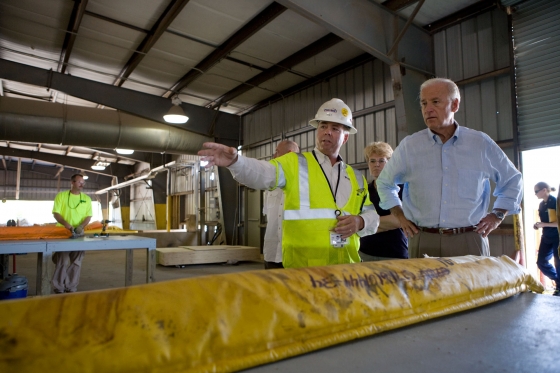 Vice President Joe Biden is led on a tour of the boom repair area by Walt Dorn of Patriot Environmental Services, at the Theodore Staging Area in Alabama, July 22, 2010. Credit: White House Vice President Joe Biden is led on a tour of the boom repair area by Walt Dorn of Patriot Environmental Services, at the Theodore Staging Area in Alabama, July 22, 2010. Credit: White House
|
Coastal states, local governments, fishermen, and environmentalists came together to fight for amendments to the Outer Continental Shelf Lands Act, seeking a more rigorous and structured environmental review process, as well as a voice in that process. Amending the Act took four years, and from many accounts was extremely divisive. From an environmental perspective, the resulting amendments contained important provisions that required consideration of environmental factors in decision-making, as well as an increased level of scientific study to support those decisions. The amendments specifically stated that, “Management of the outer Continental Shelf shall be conducted in a manner which considers economic, social, and environmental values of the renewable and nonrenewable resources contained in the outer Continental Shelf, and the potential impact of oil and gas exploration on other resource values of the outer Continental Shelf and the marine, coastal, and human environments.”[index.html#end19 19]
The amendments required that the timing and location of exploration, development, and production of offshore oil and gas take a number of environmental factors into consideration, including: existing ecological characteristics; an equitable sharing of development benefits and environmental risks among the regions; the relative environmental sensitivity and marine productivity of areas; and relevant environmental and predictive information.[index.html#end20 20] Based on an evaluation of these and other factors, the amended act directed the Secretary of the Interior to select the “timing and location of leasing, to the maximum extent practicable, so as to obtain a proper balance between the potential for environmental damage, the potential for the discovery of oil and gas, and the potential for adverse impact on the coastal zone.”[index.html#end21 21]
In order to assist in making these decisions based on sound science, the amended act directed the Secretary of the Interior to conduct studies to: establish information needed for assessment and management of environmental impacts of oil and gas activities on the human, marine, and coastal environments of the OCS; predict impacts on the marine biota from chronic low level pollution or large spills associated with OCS production; and to monitor the human, marine, and coastal environments in a manner designed to identify significant changes in the quality or productivity of such environments, as well as their causes.[index.html#end22 22] The amended act also required the Secretary of the Interior to take available and relevant environmental information into account when making decisions related to plans and permits, developing regulations and lease conditions, and issuing operating orders. In conducting this OCS research, the amended act directed the Secretary of the Interior to utilize the capabilities of the Department of Commerce (through the [../154781/index.html National Oceanic and Atmospheric Administration] (NOAA)) to the maximum extent practicable.
By the late-1970s, as a result of both the 1978 Amendments to the Outer Continental Shelf Lands Act and a suite of new environmental laws mentioned previously, the Department of the Interior was operating in a new legal regime for OCS oil and gas. The requirement to consider environmental impacts and consult with other federal agencies was much more explicit and rigorous. Together, these laws helped to elevate the importance of the Environmental Studies Program, because the program was in charge of implementing the mandated research and environmental information requirements.
In the early 1980s, the Environmental Studies Program began focusing on developing a better understanding of oceanographic processes that influence the long-term cumulative effects of OCS oil and gas development and production activities, as well as placing an increased emphasis on synthesis and distribution of studies information.[index.html#end23 23] The Environmental Studies Program was then incorporated into the [../154631/index.html Minerals Management Service] (MMS)[index.html#end24 24] when it was formed in 1982.
In 1986, [../154631/index.html MMS] requested that the National Research Council conduct a complete review of the Environmental Studies Program. The National Research Council was specifically requested to “evaluate the adequacy and applicability of studies conducted in the [Environmental Studies Program], review the general state of knowledge in the appropriate disciplines, and recommend future studies.[index.html#end25 25] The National Research Council divided the work between three panels – physical oceanography, ecology, and socioeconomics. Major recommendations from the reports are contained in Table 1. While the National Research Council was preparing the three reports, “the OCS committee and its panels interrupted their work to prepare two [additional] reports on the adequacy of environmental information for OCS decisions in response to government requests.”[index.html#end26 26] The first request came from President George H.W. Bush, and was related to lease sales off of Florida and California (report published in 1989); the second was requested by [../154631/index.html MMS], and focused on a north Atlantic lease sale (report published in 1991).27
Both the Outer Continental Shelf Lands Act Amendments of 1978 and the [../154774/index.html National Environmental Policy Act] require consideration of social and economic factors in oil and gas decision-making. In the late 1990s, [../154631/index.html MMS] began to place a higher emphasis on socioeconomic research, including hosting the first MMS National Social and Economic Planning Conference.[index.html#end28 28] In 2000, the Environmental Studies Program published a document specific to the role of social science in decision-making for OCS oil and gas development. This applied social science framework for decision-making responded to major recommendations about social and economic studies made by the MMS Scientific Committee; the National Research Council (including recommendations from the previously discussed 1992 Socioeconomics Panel Report); and from various MMS-sponsored conferences and workshops.[index.html#end29 29] The 2000 framework linked the eight components of social and economic studies[index.html#end30 30] to the data needs and sequencing of the [../154631/index.html MMS] decision making process, and asserted the importance of research on the social and economic impacts of energy development to MMS and the public.
Another development that broadened the focus of the Environmental Studies Program came when the [../152431/index.html Energy Policy Act]of 2005 specifically authorized the Secretary of the Interior to grant leases on the Outer Continental Shelf for the purposes of producing or supporting “production, transportation, or transmission of energy from sources other than oil and gas.”[index.html#end31 31] The Energy Policy Act of 2005 also directed the Secretary of the Interior to establish “an interagency comprehensive digital mapping initiative for the outer Continental Shelf” in cooperation with the Secretaries of Commerce and Defense, and the Commandant of the Coast Guard “to assist in decisionmaking” relating to the siting of alternative ocean energy sources.[index.html#end32 32] The result of this mapping mandate was the creation of the Multipurpose Marine Cadastre, which is “an integrated marine information system that provides legal, physical, ecological, and cultural information in a common geographic information system (GIS) framework,” which is particularly useful for “coastal and marine spatial planning efforts that involve finding the best location for [../155703/index.html renewable energy] projects.”[index.html#end33 33]
The provisions in the [../152431/index.html Energy Policy Act] of 2005 helped to elevate the focus on offshore renewable energy within [../154631/index.html MMS] and the Environmental Studies Program. In fiscal year 2007, the Environmental Studies Program sponsored a synthesis and analysis report “[t]o guide MMS in its development of a research program to support alternative energy uses in the OCS.”[index.html#end34 34] The results were used in a June 2007 workshop on environmental studies for alternative energy that was designed to “identify data needs and to outline potential studies for the MMS Environmental Studies Program and its partners.”[index.html#end35 35] The Fiscal Years 2009-2011 Studies Development Plan for Alternative Energy included a variety of proposed studies in the areas of oceanography, airborne resources (birds, bats, etc), aquatic biology, and social sciences. Specific projects included research on the social and economic effects of alternative energy uses; alternative [../152465/index.html energy capacity in Alaska]; field surveys for birds; wave attenuation for different wave device designs; and an evaluation of the environmental impacts of lighting schemes for offshore wind facilities.[index.html#end36 36]
In February 2009, [../154631/index.html MMS] was directed by the Secretary of the Interior to work with the U.S. Geological Survey to “assemble all the information available about the offshore resources – conventional and renewable – along with information about potential impacts.”[index.html#end37 37] The resulting report, “Survey of Available Data on OCS Resources and Identification of Data Gaps,” covered three main topics: [../155703/index.html renewable energy resources], oil and gas resources, and sensitive environmental areas and resources. The report noted that, “[o]verall, an adequate baseline of information exists to address the environmental effects of the OCS oil and gas program and the renewable energy program in support of leasing decisions,” but also recognized that “a key challenge in many areas will be to gather and synthesize existing information.”[index.html#end38 38] The report also highlighted the importance of renewable energy, stating, “While we continue to rely heavily on oil for transportation and generate a majority of our electricity from coal, renewable energy sources will play an increasingly important role as we look for ways to address environmental, economic, and energy security.”[index.html#end39 39]
On April 22, 2009, President Obama announced the signing of a Memorandum of Understanding between the Department of the Interior of the Federal Energy Regulatory Commission that clarified jurisdictional issues related to licensing and leasing for offshore [../155703/index.html renewable energy], as well as the Department of the Interior’s final framework for renewable energy on the Outer Continental Shelf.[index.html#end40 40] These announcements highlighted the more formal role that [../154631/index.html MMS] would be taking in offshore renewable energy. In December 2009, the Department of the Interior announced the creation of a new MMS Atlantic regional office to support east coast offshore renewable energy development.[index.html#end41 41] Although some stakeholders were happy to see an expanded focus on offshore renewable energy, some researchers have expressed concern that the creation of the Atlantic OCS Office and the increased emphasis on renewable energy is having negative impacts on the funding available for oil and gas environmental studies, particularly in the [../158852/index.html Gulf of Mexico (Deepwater Gulf of Mexico oil reserves and production)].[index.html#end42 42]
Operation of the Environmental Studies Program in the Current Era
Funding and Selection of Studies
Since the Environmental Studies Program began in 1973, it has funded more than $875 million in studies through fiscal year 2010.[index.html#end43 43] Current annual funding for extramural research is approximately $30 million, which also includes funding for OCS renewable energy and the sand and gravel program. Figures 1 and 2 show the budget for 1973-2010 in both real (2005) and nominal dollars.
Based on conversations with [../154631/index.html MMS] staff, the Environmental Studies Program agenda has evolved to be driven by regional information needs that are linked to planning, leasing, exploration, and development decisions that need to be made by MMS and DOI.[index.html#end44 44] The studies are focused on areas with known leases and activities, or areas that are most likely to be chosen for development or production in the future. The Environmental Studies Program focuses on mission specific studies, only funding research for scientific information that is directly relevant to current or future decision-making by the agency.[index.html#end45 45]
In order to make funding decisions, there is an annual process to assess information needs and to set priorities for research. This process has its foundations in changes that were made to the program in the late 1970s – the first Regional Studies Plan was prepared in 1978 when the Environmental Studies Program was part of the Bureau of Land Management.[index.html#end46 46] Regional Studies Development Plans are currently developed in each of the [../154631/index.html MMS] regions based on policy and guidance provided by MMS Headquarters, as well as stakeholder input. The Regional Studies Development Plans contain background on the OCS region, including projected OCS activities; identification of information needs for the region; ongoing and proposed study profiles; and proposed areas for future research. They are considered to “provide the link between decisions, information needs incident[al] to decisions, and individual studies to satisfy information needs.”[index.html#end47 47] In some cases, study results can directly lead to industry requirements for environmental protection – research on [../158851/index.html chemosynthetic] communities in the Gulf of Mexico led to progressively stronger Notice to Lessee requirements (NTL 88-G11 and NTL 2000-G20) for avoiding impacts to these communities.[index.html#end48 48] However, some researchers interviewed by the Commission raised the concern that there could sometimes be a lack of connection between study results and MMS regulations.[index.html#end49 49]
Because there are generally more studies proposed than can be funded, management in the regions and [../154631/index.html MMS] headquarters work together to turn the Regional Studies Development Plans into a priority National Studies List. Inclusion on the national list is based on: “importance of the information to the decision maker”; “date of the resource-management decision for which the study is designed”; “generic applicability of results or techniques from the study”; “status of the information”; and “applicability of the study to issues of regional or programmatic concern.”[index.html#end50 50] Once the national list is approved by MMS Headquarters, each region will begin procuring the studies. Individual studies on the National Studies List are awarded through a competitive procurement process, cooperative agreements, or inter-agency agreements.[index.html#end51 51]
Based on interviews with researchers, the Commission received a number of suggestions for improving the Environmental Studies Program and its selected studies. One suggestion was for the creation of clear ecological goals and objectives to improve the linkages between natural resource management and habitat conservation at [../154631/index.html MMS] to ecological science. It was also proposed that MMS should seek to protect different [../153222/index.html habitats] based on their ecological functions – shifting from the basic habitat mapping that currently occurs to a focus on measurement of ecological sensitivity and determination of ecological functions in potential lease areas. Another suggestion was for the Environmental Studies Program to improve how it builds upon past study results, particularly in the area of hypothesis development and sampling design, and to make better use of prior study data.[index.html#end52 52] Based on the fact that it has been almost twenty years since the last National Research Council review of the Environmental Studies Program was conducted, it may be appropriate for such an assessment to occur in the near future.
Study Partnerships
 Grand Isle resident's response, a mock graveyard of the Delta's products and gifts. Credit: Gary Braasch Grand Isle resident's response, a mock graveyard of the Delta's products and gifts. Credit: Gary Braasch
|
Because [../154631/index.html MMS] does not maintain its own scientific research capabilities, almost all studies conducted under the Environmental Studies Program are executed by outside groups. Parties conducting the research include other federal agencies ([../154781/index.html NOAA (National Oceanic and Atmospheric Administration (NOAA), United States)], U.S. Geological Survey, [../156779/index.html U.S. Fish and Wildlife Service], etc); state institutions or universities; Coastal Marine Institutes; Cooperative Ecosystem Studies Units; and others. Discipline areas covered by the studies include (listed in order of decreasing MMS expenditures for 2005-2010): [../153222/index.html habitat] and [../151932/index.html ecology]; [../161761/index.html marine mammals (Deepwater Horizon Oil Spill and Marine Mammals)] and [../152414/index.html protected species]; physical oceanography; sociology and economics; information management; fates and effects; and air quality.[index.html#end53 53]
Federal Agencies. A number of studies, some of them long-term in nature, are conducted by federal agencies with MMS funding under interagency agreements or contracts. For example, three major multi-year studies of [../163071/index.html bowhead whales] and other marine mammals in the Arctic are currently being conducted under an interagency agreement between [../154631/index.html MMS] and [../154781/index.html NOAA (National Oceanic and Atmospheric Administration (NOAA), United States)] – some of the survey data sets go back to 1979.[index.html#end54 54] Other oil and gas related research conducted by NOAA with MMS funding includes studies on the diving patterns of sperm whales in the [../150279/index.html Atlantic Ocean]; estimation of fisheries impacts from the use of underwater explosives to remove oil and gas platforms in the Gulf of Mexico; and the association of [../159136/index.html sea turtles] with oil and gas platforms in the [../162676/index.html Gulf of Mexico (Federal environmental review of oil and gas activities in the Gulf of Mexico: environmental consultations, permits, and authorizations)].[index.html#end55 55] Research conducted by the [../156779/index.html U.S. Fish and Wildlife Service] for MMS includes foraging and breeding of the marbled murrelet in California; polar bear feeding ecology studies in the Arctic; and the winter distribution and abundance of Steller's eiders in [../151451/index.html Cook Inlet, Alaska].[index.html#end56 56] The U.S. Geological Survey has also been involved in research for the Environmental Studies Program, including an ongoing multi-year study of the timing and duration of habitat use by spectacled eiders within the [../151116/index.html Chukchi] and [../150457/index.html Beaufort] Seas; and a completed multiyear study (conducted jointly with the Energy Division of the County of Santa Barbara, California) on natural offshore oil seepage and related [../158463/index.html tarball] accumulation on the California coastline.[index.html#end57 57]
Coastal Marine Institutes: Coastal Marine Institutes are formed by cooperative agreements between universities and [../154631/index.html MMS]. For the Gulf of Mexico, the Coastal Marine Institute at Louisiana State University was established in 1993. Under the cooperative agreement, MMS and the Coastal Marine Institute jointly agree on the most important research needs in the context of the MMS [../160618/index.html offshore oil and gas (A brief history of offshore oil drilling)]program. Objectives of the cooperative agreement include: responding to information needs and interests with local expertise; broadening recognition and comprehension of study results through the work of a highly credible local research institution; improving the existing local capabilities and facilities for scientific research; and reducing the cost of obtaining scientific information through co-funding.[index.html#end58 58] In the Pacific OCSRegion, a Coastal Marine Institute administered by the Coastal Research Center of the Marine Science Institute at University of California Santa Barbara was formed in 1994. The focus of the Pacific Coastal Marine Institute is “long-term environmental, social and economic consequences of oil and gas production activities in the Pacific Outer Continental Shelfregion.”[index.html#end59 59] Finally, the University of Alaska Coastal Marine Institute was created by a cooperative agreement between the University of Alaska and [../154631/index.html MMS]to study coastal topics associated with the development of natural gas, oil, and minerals in Alaska's OCS, with many of the Institute’s projects addressing issues related to fisheries, biomonitoring, physical oceanography, and the fates of oil.[index.html#end60 60]
Based on Commission interviews with academic researchers, the Coastal Marine Institutes were initially seen by external partners as a good way to increase academic participation in the Environmental Studies Program, bringing both an influx of new study participants and ideas. More recently, one researcher noted that “stagnant then decreasing funding, crippling match requirements, and a general disinterest within MMS have greatly decreased the value of this program.”[index.html#end61 61]
Additional Funding through the National Oceanographic Partnership Program: The National Oceanographic Partnership Program can also serve as a funding mechanism for research on topics important to decision-making for offshore energy. The NOPP was established by Congress in 1998 to: (1) “promote the national goals of assuring national security, advancing economic development, protecting quality of life, and strengthening science education and communication through improved knowledge of the ocean;” and (2) “coordinate and strengthen oceanographic efforts in support of those goals by identifying and carrying out partnerships among federal agencies, academia, industry, and other members of the oceanographic scientific community in the areas of data, resources, education, and communication.”[index.html#end62 62] “The NOPP focuses on ocean-related objectives which are too large for single agencies to undertake, but satisfy multiple agency missions and would benefit from partnerships between government, private industry and academia.”[index.html#end63 63] In fiscal year 2010, [../154631/index.html MMS], Department of Energy, and [../154781/index.html NOAA (National Oceanic and Atmospheric Administration (NOAA), United States)] funded almost $5 million in research projects through NOPP that were focused on the development of environmental protocols and monitoring needed to support [../162760/index.html ocean renewable energy] and stewardship.[index.html#end64 64]
External Review of Studies and Information Transfer
[../154631/index.html MMS] staff note that the agency invites external participation from both federal and non-federal scientists throughout the life of the studies projects, including: developing statements of work for studies, participating on proposal reviews, serving as project inspectors, and reviewing MMS reports after the study project is complete.[index.html#end65 65] However, based on Commission staff research, the amount and style of external outreach does not appear to be consistent between MMS regions.
MMS has a national science review board, the OCS Scientific Committee, which was established to provide independent review of the Environmental Studies Program. The OCS Scientific Committee gives “advice to the Secretary of the Interior, through the Director of the Minerals Management Service, on the feasibility, appropriateness, and scientific value” of the program.[index.html#end66 66] Members of the Committee review the draft Regional Studies Development Plans and provide input on the studies and the overall ranking of research priorities.[index.html#end67 67] The Committee currently meets only once a year for 2 days, but Subcommittees may meet more frequently during the year to discuss particular topics.[index.html#end68 68] Some Committee members believe that the Science Committee currently plays a relatively limited role that should be expanded.[index.html#end69 69]
In addition to work with the OCS Scientific Committee, [../154631/index.html MMS] staff have noted that transfer of scientific information from the Environmental Studies Program back to the public, federal agencies, and academics occurs in a variety of manners:
- The Environmental Studies Program Information System makes all completed Environmental Studies Program reports and technical summaries available online – over 4000 electronic documents are available. MMS is currently planning an enhanced version of this system that will provided a geospatial search tool for the reports and could be useful for coastal and marine spatial planning efforts.
- MMS provides sponsorship for symposia and conferences.
- Some journal articles are published by MMS staff or scientists conducting research for MMS.[index.html#end70 70]
MMS also sponsors biannual Information Transfer Meetings every two years in the Gulf of Mexico and Alaska. These meetings bring together scientists and regulators from throughout the United States and the world to discuss research topics funded by the Environmental Studies Program and related areas of interest to MMS.[index.html#end71 71] The Information Transfer Meetings provide an opportunity for a two-way information exchange on OCS energy study topics in a variety of fields, such as archaeology, [../151486/index.html coral reefs], deepwater, economic effects of the oil industry, fish, geology, [../154990/index.html ocean currents], oil spill research, pinnacles, platforms, and [../152414/index.html protected species].[index.html#end72 72] MMS staff indicate that the Information Transfer Meetings serve as an opportunity for peer review of study design, methodology, and results.[index.html#end73 73]
Some members of the OCS Science Committee and environmental NGOs have questioned the level of formal peer review that studies from the program undergo. Similar to recommendations in the 1990 National Research Council review, they have encouraged more study results to be published in peer-reviewed journals.[index.html#end74 74] In response, Environmental Studies Program staff note that researchers are encouraged to publish their study results in peer-reviewed journals, but point out that peer review, as defined by the White House Office of Management and Budget (OMB), takes more forms than just journal articles.[index.html#end75 75] For peer review guidance, MMS relies on the OMB Final Information Quality Bulletin for Peer Review (published in 2004), which applies to all federal government agencies and departments, and “establishes government-wide guidance aimed at enhancing the practice of peer review of government science documents.”[index.html#end76 76] Peer review is not the same as public comment or other stakeholder processes – it is a scientifically rigorous review and critique of a study’s methods, results, and findings by others in the field with requisite training expertise. The bulletin notes that peer review can “take a variety of forms, depending on the nature and importance of the product.”[index.html#end77 77] It also makes clear that regardless of the mechanism for peer review, “agencies should strive to ensure that their peer review practices are characterized by both scientific and process integrity.”[index.html#end78 78]
[../154631/index.html MMS] staff believe that the agency fulfills OMB’s peer review requirements through a variety of methods, which include: reviews by the OCS Scientific Committee; involving federal and non-federal scientists in multiple steps of the environmental studies process; convening quality and science review boards; conducting Information Technology Transfer meetings and workshops; reviews of MMS reports by internal and external scientists; encouraging publication of studies results in scientific journal publications; and engaging in international and national conferences.[index.html#end79 79] MMS staff have also pointed out that waiting for journal articles to be published before data can be incorporated into decision-making would significantly slow the process, which is specifically designed to provide the latest data and research needed for oil and gas decisions at MMS.[index.html#end80 80]
Summary and Conclusions
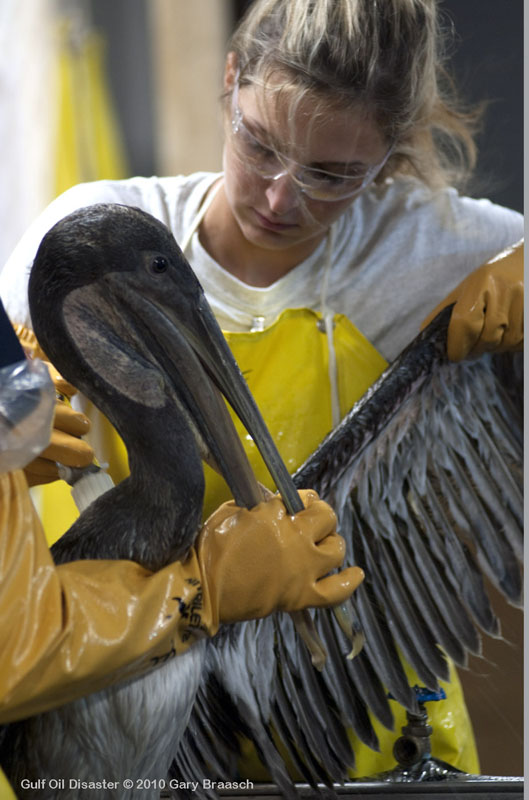 Oiled brown pelican being washed at Hammond Wildlife Rehabilitation Center. 8180 birds have been brought in from the oiled area, and only 2076 were found alive and survived. Credit: Gary Braasch Oiled brown pelican being washed at Hammond Wildlife Rehabilitation Center. 8180 birds have been brought in from the oiled area, and only 2076 were found alive and survived. Credit: Gary Braasch
|
The Environmental Studies Program has significantly evolved since it was first established in 1973. Most importantly, the program has contributed a great deal of science to aid in understanding the offshore areas where energy development is already occurring, or may occur in the future. Commission interviews and research have generally revealed a high level of respect for the quality of science conducted under the program (depending on the researcher conducting the project). Additionally, leadership within the Environmental Studies Program has a clear focus on the need for the science to be relevant to decision-making and policy within the Department of the Interior and [../154631/index.html MMS]. As the program moves forward and continues to evolve to meet future demands, it will be important for its science to be conducted in a strategic fashion that builds upon past studies; indentifies data gaps, particularly in frontier areas; and systematically fills those gaps to both enhance scientific knowledge in leasing areas, and to measure and understand the impacts of [../160618/index.html offshore oil and gas (A brief history of offshore oil drilling)] activities. Partnerships across the government with other science agencies will be important to leverage resources and expertise for future research. The outstanding question of the most appropriate methods for peer review of the research should also be considered.
End Notes
1 Hearings on Bills to Amend the Federal Water Pollution Control Act, as Amended, and Related Matters Pertaining to the Prevention and Control of Water Pollution, before the Subcommittee on Air and Water Pollution of the Committee on Public Works of the United States Senate, 91st Congress, 1st Session (Washington, D.C: U.S. GPO, February 5, 1969), 342.
2 The Gulf of Mexico spills occurred at Chevron Main Pass 41 and Shell’s Bay Marchand.
3 Richard Andrews, Managing the Environment, Managing Ourselves: A History of American Environmental Policy (New Haven: Yale University Press, 2006), 224.
4 National Research Council, Assessment of the U.S. Outer Continental Shelf Environmental Studies Program: III. Social and Economic Studies (Washington, D.C.: National Academies Press, 1992), 11.
5 Andrews, Managing the Environment, Managing Ourselves: A History of American Environmental Policy, 201.
6 Michael Kraft, Environmental Policy and Politics (Pearson Education Inc., 2011), 93.
7 Kraft, Environmental Policy and Politics, 94.
8 Andrews, Managing the Environment, Managing Ourselves: A History of American Environmental Policy, 227.
9 42 U.S.C. § 4331(a).
10 42 U.S.C. § 4332; see e.g., 40 C.F.R. § 1502.19.
11 Strycker’s Bay Neighborhood Council, Inc v. Karlen, 444 U.S. 223, 227 (1980).
12 Herbert Kaufman and Cheryl Anderson, ed., Outer Continental Shelf Environmental Studies Program Contract Projects – Fiscal Years 1973-1983 (December 1983), II-1.
13 National Research Council, Assessment of the U.S. Outer Continental Shelf Environmental Studies Program: I. Physical Oceanography (Washington D.C.: National Academies Press, 1990), 15.
14 Minerals Management Service, Leasing Oil and Natural Resources: Outer Continental Shelf (2005), 12.
15 National Research Council, OCS Oil and Gas: An Assessment of the Department of Interior Environmental Studies Program (Washington D.C.: National Academies Press, 1978), 1.
16 Kaufman and Anderson, Outer Continental Shelf Environmental Studies Program Contract Projects – Fiscal Years 1973-1983, II-1.
17 National Research Council, Assessment of the U.S. Outer Continental Shelf Environmental Studies Program: III. Social and Economic Studies (Washington D.C.: National Academies Press, 1992), app. C, 111.
18 National Research Council, OCS Oil and Gas: An Assessment of the Department of Interior Environmental Studies Program, 10.
19 43 U.S.C. § 1344(a)(1).
20 43 U.S.C. § 1344(a)(2).
21 43 U.S.C. § 1344(a)(3).
22 43 U.S.C. § 1346.
23 Minerals Management Service, Leasing Oil and Natural Resources: Outer Continental Shelf, 12.
24 On June 18, 2010, Secretary of the Interior Ken Salazar signed a Secretarial Order (No. 3302) to reorganize the Minerals Management Service (MMS) into to the Bureau of Ocean Energy Management, Regulation, and Enforcement (BOEMRE). On January 19, 2011, BOEMRE was further split into the Bureau of Ocean Energy Management (BOEM) and the Bureau of Safety and Environmental Enforcement (BSEE). BOEM is currently responsible for the Environmental Studies Program. In order to avoid confusion with the different names, this staff working paper will refer only to MMS (both for past and current topics).
25 National Research Council, Assessment of the U.S. Outer Continental Shelf Environmental Studies Program: II. Ecology (Washington D.C.: National Academies Press, 1992), 1.
26 Ibid.
27 Ibid.
28 Harry Luton and Rodney Cluck, Applied Social Science in MMS: A Framework for Decisionmaking (February 3, 2000), 177.
29 Luton and Cluck, Applied Social Science in MMS: A Framework for Decisionmaking, 156.
30 The eight categories of social and economic studies are: issues identification, national economic analysis, region-level analysis, community/individual level analysis, resource-use issues, adaptive policy studies, mitigation, and monitoring.
31 Energy Policy Act of 2005, Pub. L. No. 109-58, § 388 (2005).
32 Ibid.
33“About,” Marinecadastre.gov.
34 Jacqueline Michel et al., MMS 2007-03 Worldwide Synthesis and Analysis of Existing Information Regarding Environmental Effects of Alternative Energy Uses on the Outer Continental Shelf (July 2007), 1-1.
35 Jacqueline Michel and Elizabeth Burkhard, MMS 2007-057 Workshop to Identify Alternative Energy Environmental Information Needs – Workshop Summary (October 2007), 1.
36 Minerals Management Service, Fiscal Years 2009-2011 Studies Development Plan – Alternative Energy (2009).
37 Press Release, Department of the Interior, Secretary Salazar Details Strategy for Comprehensive Energy Plan on U.S. Outer Continental Shelf, February 10, 2009.
38 Minerals Management Service, MMS 2009-015: Report to the Secretary – Survey of Available Data on OCS Resources and Identification of Data Gaps (2009), IV-2.
39 Ibid. IV-3.
40 Press Release, Minerals Management Service, President Obama, Secretary Salazar Announce Framework for Renewable Energy Development on the U.S. Outer Continental Shelf, April 22, 2009.
41 Press Release, Minerals Management Service, Salazar Announces MMS Plan to Establish Atlantic Renewable Energy Office, December 9, 2009.
42 Interviews with academic researchers, September and October 2010.
43Bureau of Ocean Energy Management, Regulation and Enforcement, Alaska Annual Studies Plan: Final FY 2011 (October 2010), 1.
44 Interviews with government officials, October and November 2010.
45 James Kendall and Rodney Cluck, “BOEMRE Environmental Studies Program – Presentation to the Presidential Commission” (presentation, Washington, D.C., October 19, 2010).
46 Robert Avent, MMS 2004-015 Minerals Management Service Environmental Studies Program: A History of Biological Investigations in the Gulf of Mexico, 1973-2000 (April 2004), 31.
47 B. Fritts Golden, Rogers, and Halpern, Making Environmental Information Available to the Public: A Review of the Outer Continental Shelf Program, with Recommendations for Other Programs (November 1980), 13.
48 Kendall and Cluck, “BOEMRE Environmental Studies Program – Presentation to the Presidential Commission.”
49 Interviews with academic researchers, September and October 2010.
50 Minerals Management Service, Leasing Oil and Natural Resources: Outer Continental Shelf, 12.
51 Minerals Management Service, Leasing Oil and Natural Resources: Outer Continental Shelf, 13.
52 Interviews with academic researchers, September and October 2010.
53 Kendall and Cluck, “BOEMRE Environmental Studies Program – Presentation to the Presidential Commission.”
54 “National Marine Mammal Laboratory: Cetacean Assessment and Ecology Program: Bowhead Whale Aerial Surveys: Preliminary Data,” NOAA (2010).
55 Debra Palka and Mark Johnson, eds., MMS 2007-033 Cooperative Research to Study Dive Patterns of Sperm Whales in the Atlantic Ocean (May 2007); Gregg R. Gitschlag, Michael J. Schirripa, and Joseph E. Powers, MMS 2000-087 Estimation of Fisheries Impacts Due to Underwater Explosives Used to Sever and Salvage Oil and Gas Platforms in the U .S . Gulf of Mexico: Final Report (April 2001); Rem Lohoefener et al., MMS 90-0025 Association of Sea Turtles with Petroleum Platforms in the North-Central Gulf of Mexico (June 1990).
56 C. John Ralph, Sherri Miller, and Brian O’Donnell, MMS 93-0009 Capture and Monitoring of Foraging and Breeding of the Marbled Murrelet in California During 1990 (November 1990); “Polar Bear Feeding Ecology Study,” US Fish and Wildlife Service – Marine Mammal Management; William Larned, MMS 2006-066 Winter distribution and abundance of Steller's eiders (Polysticta stelleri) in Cook Inlet, Alaska, 2004-2005 (December 2006).
57 Bureau of Ocean Energy Management, Regulation and Enforcement, Environmental Studies Program: Ongoing Studies, (November 2010); Thomas D. Lorenson et al., Natural Offshore Seepage and Related Tarball Accumulation on the California Coastline; Santa Barbara Channel and the Southern Santa Maria Basin; Source Identification and Inventory (January 2010).
58 “Coastal Marine Institute,” BOEMRE, September 28, 2010.
59 “Coastal Marine Institute: Minerals Management Service & University of California,” BOEMRE, December 17, 2010.
60 “Coastal Marine Institute,” University of Alaska-Fairbanks, April 21, 2010.
61 Interview with academic researcher, September 2010.
62 “Program Overview,” National Oceanographic Partnership Program, 2010.
63 Ibid.
64 Press Release, National Oceanographic Partnership Program, “BOEMRE, DOE, and NOAA Announce Nearly $5 Million for Joint Environmental Research Projects to Advance Ocean Renewable Energy,” October 26, 2010.
65 James Kendall and Rodney Cluck, “BOEMRE Environmental Studies Program – Presentation to the Presidential Commission.”
66 Minerals Management Service, Outer Continental Shelf Scientific Committee Charter, filed March 10, 2010.
67 Interview with government officials, October 2010.
68 Interviews with OCS Scientific Committee members, September 2010.
69 Ibid.
70 Interview with government officials, October 2010.
71 Melanie McKay and Judith Nides, eds, MMS 2009-051 Proceedings: Twenty-Fifth Gulf of Mexico Information Transfer Meeting (January 2009), xv.
72 “Proceedings of Information Transfer Meetings,” BOEMRE, September 29, 2010.
73 Interview with government officials, October 2010.
74 Interviews with NGO groups and OCS Scientific Committee members, September and October 2010.
75 Ibid.
76 Joshua Bolten, memorandum to Heads of Departments and Agencies, December 16, 2004.
77 Ibid. 5.
78 Ibid. 13.
79 James Kendall, “Scientific Peer and Stakeholder Input to Programs,” (presentation, MMS Scientific Committee Arctic Subcommittee, February 8, 2005).
80 Interviews with government officials, October and November 2010.
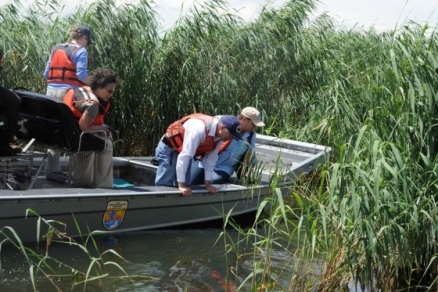
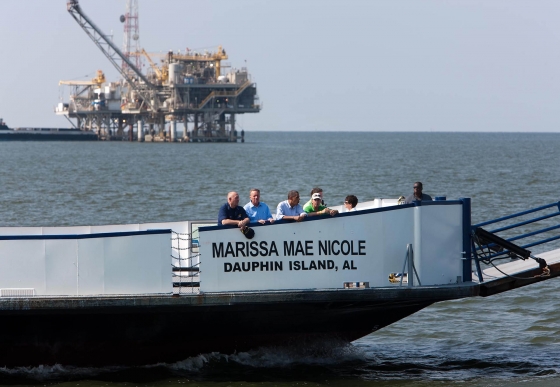
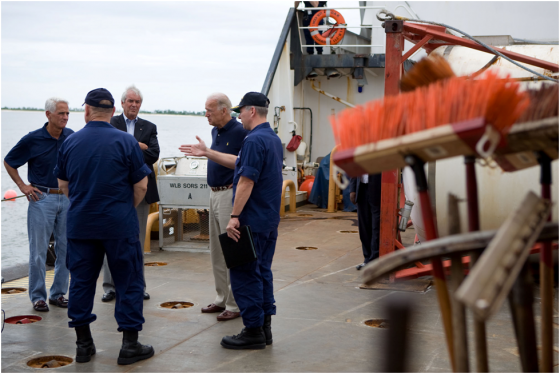
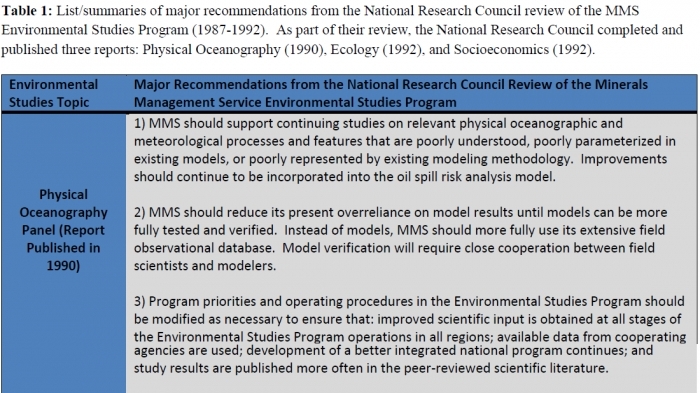
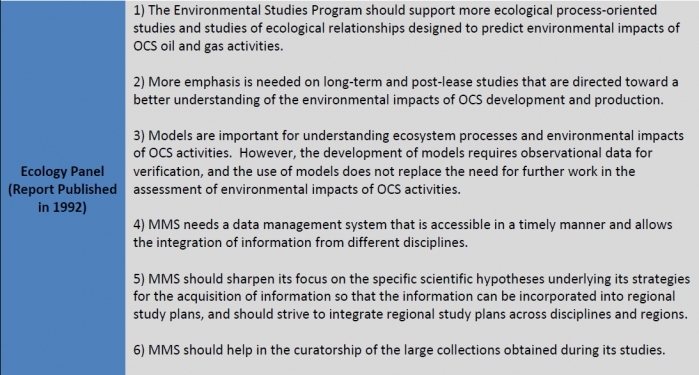
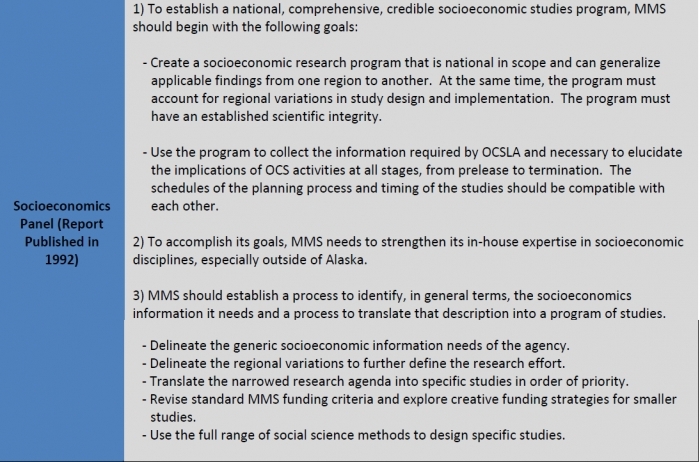
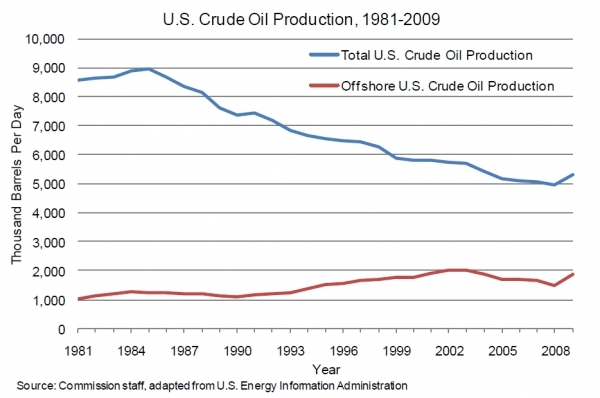
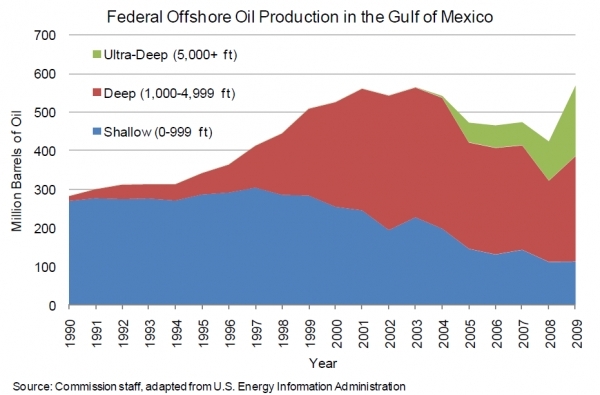
0 Comments